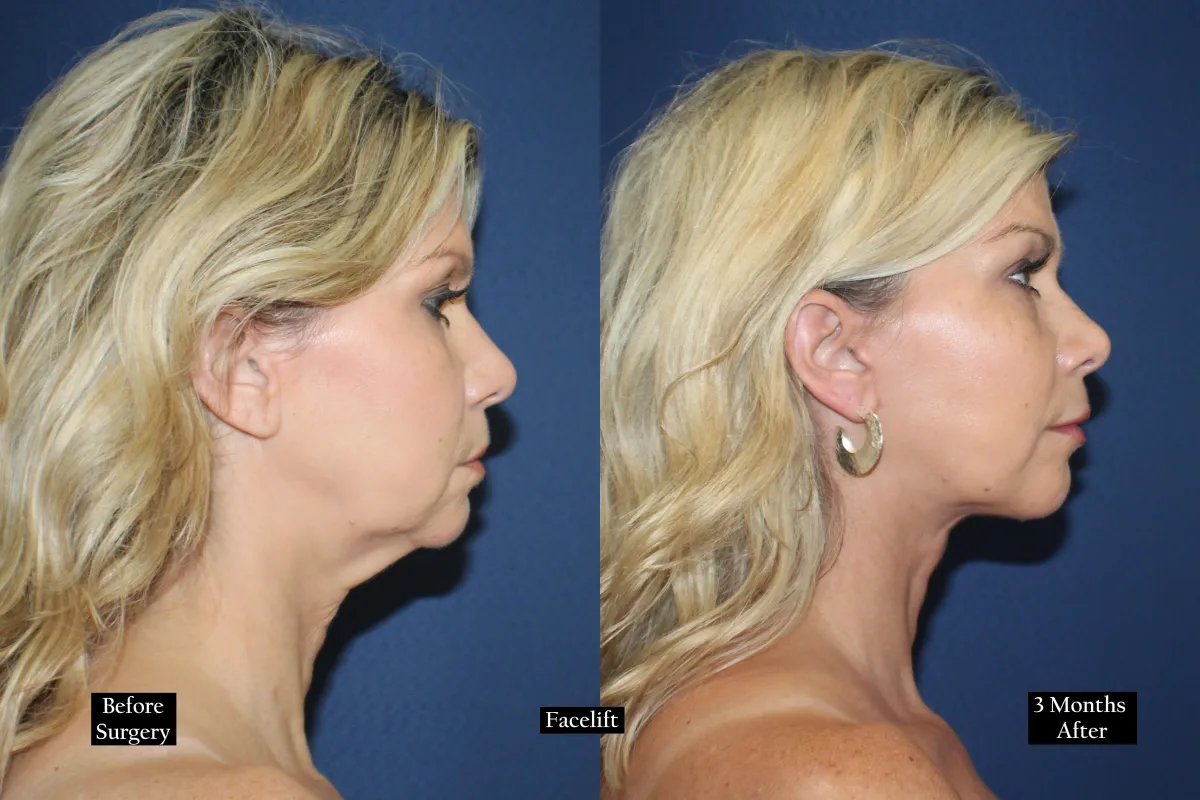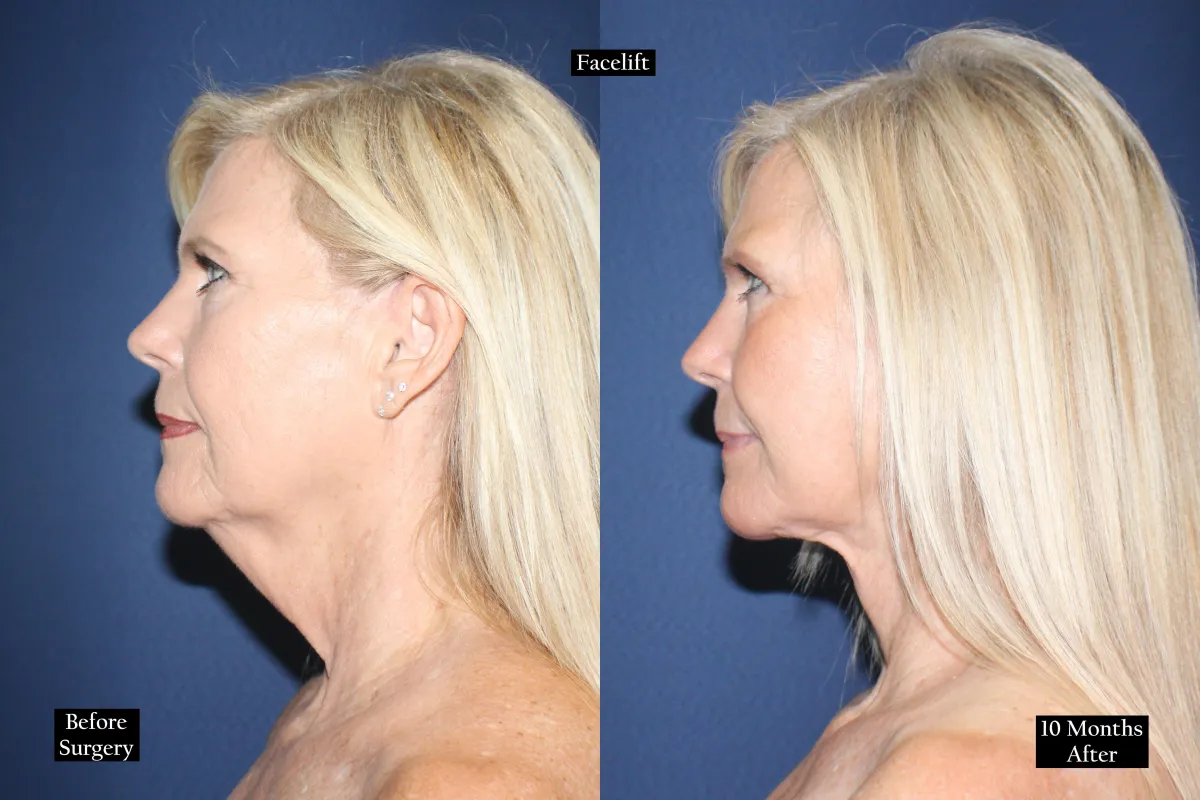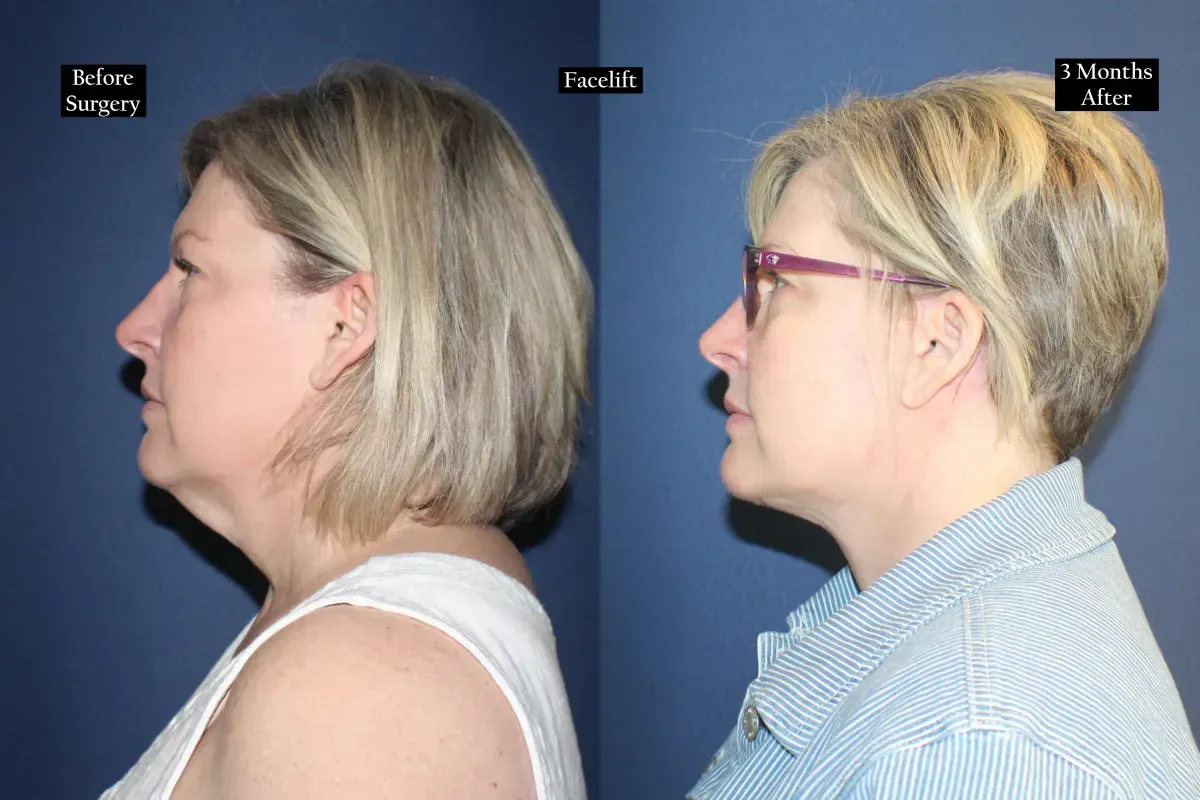
(901) 675-7925

204 23rd Avenue N. Nashville, TN 37203
Facelift
Nashville's Premier Surgeon
When it comes to YOUR body, CHOOSE the BEST
- Dr. Sieveking
WHAT EXACTLY IS A FACELIFT?
Facelifts remove and tighten excess skin and reposition fat deposits and muscles that have sagged or warped over time. Facelift procedures can remove deep-set wrinkles, sagging jowls, fatty deposits or banding on the face and neck. This is accomplished by removing or repositioning fat to areas which will fill in wrinkled or sagging skin, as well as reducing and tightening skin around the lower jaw.
Facelifts fall into several categories: Full, lower, and mini lifts:
Full facelifts: A full facelift is the most complex type of facelift because it is a combination of separate procedures that work together to rejuvenate the overall appearance of the face. Because everyone ages differently, the procedures that work for one person could be completely inappropriate for another. The surgeries generally included in a full facelift target the lower face, mid-face and neck.
Lower facelifts: Lower facelifts target only the lower portion of the face and are used to sculpt the skin and tissue around the mouth, jaw and neck. Lower facelifts help to remove the signs of weariness and falsely expressed emotions (sadness, anger, fatigue) which can look permanent on aging skin.
Mini facelifts: Mini facelifts generally involve a single incision site along the ear. This tiny S-shaped incision is designed to be virtually invisible once healed. Also known as the “weekend facelift,” this procedure is popular among women aged 40-50 who have only just begun to show signs of aging. Skin that has severe deep wrinkles and signs of aging would not generally benefit much from a mini facelift.


WHEN IT COMES TO YOUR BODY, CHOOSE THE BEST
Dr. Nicholas E. Sieveking is a board-certified and award-winning plastic surgeon in Nashville, TN. He balances his body contouring services with his busy plastic surgery practice where he has developed a reputation as one of the top mommy makeover surgeons in the region. He is known as a safe and conservative plastic surgeon and for achieving predictable and “natural results” without extreme changes in his patients.
Dr. Sieveking is a native Nashvillian with over 20 years of experience and completed his medical training in general surgery and plastic and reconstructive surgery at Stanford University in Palo Alto, California. After finishing his training at Stanford, Dr. Sieveking traveled to Rio de Janeiro and Santos, Brazil to be a student of two of the world’s leaders in plastic surgery- Ivo Pitanguy and Ewaldo Bolivar de Souza Pinto.

CAN A FACELIFT BE COMBINED WITH OTHER PROCEDURES?
a facelift can be combined with other cosmetic procedures to achieve comprehensive facial rejuvenation.
Neck Lift:
Combining a neck lift with a facelift can address signs of aging in both the lower face and neck region, providing overall facial rejuvenation. A facelift targets sagging skin, deep creases, and loss of volume in the mid to lower face.
Chin Augmentation or Reduction:
Neck lift surgery can be combined with procedures to enhance the appearance of the chin, such as chin augmentation with implants or chin reduction to improve facial balance and profile.
Blepharoplasty (Eyelid Surgery):
Eyelid surgery can address sagging or puffy eyelids, under-eye bags, and wrinkles around the eyes. Combining eyelid surgery with a neck lift can provide a more youthful and refreshed appearance to the entire face.
Liposuction:
Liposuction may be performed along with a neck lift to remove excess fat deposits in the neck and jawline area, further improving the contour and definition of the neck and jawline.
Brow Lift:
A brow lift can address sagging or drooping eyebrows, forehead wrinkles, and frown lines. Combining a brow lift with a neck lift can provide a more harmonious and balanced rejuvenation of the entire upper face and neck.
Non-Surgical Treatments:
In addition to surgical procedures, non-surgical treatments such as injectable fillers, Botox, laser skin resurfacing, or chemical peels may also be combined with a neck lift to enhance overall facial appearance and skin texture.
Combining procedures can offer several benefits, including reduced overall recovery time, cost savings, and more comprehensive results.
However, the decision to combine procedures should be carefully discussed with a qualified plastic surgeon to ensure safety and optimal outcomes based on individual needs and goals.
Facelift Transformations



FACELIFT RECOVERY


Swelling, bruising and bleeding at the incision sites are typical after a facelift. Patients should focus on resting with their head elevated for the first week after surgery to maximize healing and prevent unnecessary strain on the body.
Initially, patients may have a surgical drain placed at the incision site to reduce swelling. This drain must be emptied and reset frequently to prevent a fluid buildup. Drains are typically removed a few days after surgery. The sutures will either dissolve in a couple of weeks or be removed along with any drains.
Most patients return to office jobs within one to two weeks following surgery, depending on the extent of the facelift. Bending, lifting and strenuous exercise will be off-limits for several weeks following a facelift. Patients should take great care to follow all recovery instructions to enhance the results of the procedure and help prevent complications.
Swelling will subside over the weeks and months following surgery and patients can expect to see final results in about six months to a year. Preliminary results will be visible after about six to eight weeks.
ARE YOU THE RIGHT CANDIDATE FOR A FACELIFT?
Ideal candidates for a facelift are in general good health, have a positive self-image and attitude, realistic expectations, and the ability to devote time to the healing process.
Below are characteristics a facelift patient commonly has:
Fat deposits in the face which have shifted or fallen to create hollows or wrinkles.
Sagging skin along the jawline or fatty jowls.
Creases or folds extending from the corners of the mouth to the nose.
Marionette lines which extend from the corners of the mouth down to the chin.
A double chin resulting from fallen fat deposits or excess skin.
Creases or banding along the neck.
Any loss of muscle tone in the lower face leading to an aged appearance.

Patient Experience
Transformation Reviews
I am absolutely thrilled with the results from Dr. Sieveking as well as all of his staff. They are kind and so helpful! Every experience I have had from surgery to facial fillers has been beyond my expectations. I recommend Dr. Sieveking and his team to everyone who is interested in cosmetic surgery and procedures.
-Kristy T., Surgery Patient
"He was amazing. He gave me my life back after revising the work another doctor had done. He is very skilled and has a great eye. He had me return to the office probably 6 times over the course of many months to check on my healing. He really cares about you and his work. Thank you Dr. Sieveking!.
-Sarah Alex., Surgery Patient
Going into surgery, I was already at ease with Dr. Sieveking because of his bedside manner and professionalism. He had come so highly recommended by a personal friend, then by my GYN. Buy when my anesthesiologist said that he trusted Dr. Sieveking with his family...that was the icing on the cake. And his work? He totally exceeded my expectations.
-Donna Moore, Surgery Patient
FREQUENTLY ASKED QUESTIONS
What is a neck lift surgery?
A neck lift surgery, also known as platysmaplasty, is a cosmetic procedure designed to improve the appearance of the neck by removing excess skin, fat, and tightening underlying muscles to create a smoother and more youthful contour.
Am I a candidate for neck lift surgery?
Candidates for neck lift surgery typically include individuals who are bothered by sagging or loose skin in the neck area, prominent neck bands, or lack of definition in the jawline. A consultation with a qualified plastic surgeon can determine if you are a suitable candidate.
What is the recovery process like?
Recovery from neck lift surgery typically involves some swelling, bruising, and discomfort for the first few days to weeks. Patients are advised to avoid strenuous activities and follow post-operative instructions provided by their surgeon to ensure proper healing.
Will there be visible scarring after the procedure?
While some scarring is inevitable with any surgical procedure, a skilled surgeon will strategically place incisions in inconspicuous areas such as behind the ears or under the chin to minimize visible scarring. Over time, scars usually fade and become less noticable.
How long do the results of a neck lift last?
The longevity of results can vary depending on individual factors such as age, skin elasticity, and lifestyle habits. However, with proper care and maintenance, the results of a neck lift surgery can last for many years, providing a more youthful and rejuvenated appearance.
Are there any risks or complications associated with neck lift surgery?
Like any surgical procedure, neck lift surgery carries some risks, including infection, bleeding, nerve damage, and adverse reactions to anesthesia. However, these risks are rare when the procedure is performed by a skilled and experienced surgeon in a accredited surgical facility.
How much does neck lift surgery cost?
The cost of neck lift surgery can vary depending on factors such as the surgeon's experience, geographic location, facility fees, and the extent of the procedure. It's important to discuss pricing and financing options during your consultation with a plastic surgeon.
Have Questions?
204 23rd Avenue N. Nashville, TN 37203
(615) 321-1010


